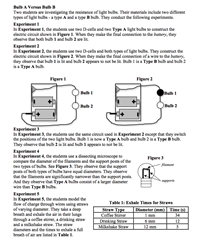 Bulb A versus Bulb B
Bulb A versus Bulb B
Resource:
Science Reasoning Center: Bulb A versus Bulb B
Grade Level: High School
Description:
This passage describes a collection of simple and related experiments involving a comparison of two different types of light bulbs. Diagrams, tables and short descriptions are used to describe the results of investigating the brightness of the bulbs when configured in circuits in various ways, the appearance of their filaments under a microscope, and a comparison of flow rates through the filaments to air flow rates through straws. Questions target a student's ability to understand an experimental design, to make inferences based on experimental results from similar studies, to draw conclusions that are consistent with provided data, to identify models that are supported by two or more data presentations, and to identify an assumption associated with a conclusion.
This activity aligns with the three dimensions of the Next Generation Science Standards in the manner described below:
| Energy (HS-PS3.A.4): Electrical energy may mean energy stored in a battery or energy transmitted by electric currents. |
This passage describes a collection of simple and related experiments involving a comparison of two different types of light bulbs. Diagrams, tables and short descriptions are used to describe the results of investigating the brightness of the bulbs when configured in circuits in various ways, the appearance of their filaments under a microscope, and a comparison of flow rates through the filaments to air flow rates through straws. Questions target a student's ability to understand an experimental design, to make inferences based on experimental results from similar studies, to draw conclusions that are consistent with provided data, to identify models that are supported by two or more data presentations, and to identify an assumption associated with a conclusion. |
| Cause and Effect: Cause and effect relationships can be suggested and predicted for complex natural and human designed systems by examining what is known about smaller scale mechanisms within the system. |
Many students do not know that it is solely the light bulb’s filament that is responsible for the flow rate of charge through the bulb and how brightly it will glow. After observing the brightness of two different type bulbs connected in various configurations, an experiment is introduced in which the students use a microscope to examine the thickness of the tiny filaments within these bulbs and learn that they are different. This is a wonderful example of how studying the smaller scale structure of an object ‘sheds light’ on what can be seen at the larger scale. |
| Structure and Function: The functions and properties of natural and designed objects and systems can be inferred from their overall structure, the way their components are shaped and used, and the molecular substructures of its various materials. |
While all incandescent light bulbs have essentially the same structure, altering the diameter of the bulb filament has a dramatic effect on the rate at which electric charge is able to pass through the bulb and thus changing the brightness of the bulb itself. While no experiment is done to directly investigate how the filament diameter affects electric current, students infer this relationship as they consider data for the flow rate of air through various diameter drinking straws. In doing so, the function and properties of a bulb filament can be inferred from its small structure.
|
Analyzing and Interpreting Data: Evaluate the impact of new data on a working explanation and/or model of a proposed process or system.
|
Five short experiments and their findings are described in this passage. As students work their way through them, they discover that each subsequent experiment ‘sheds new light’ on the why of earlier observations. Through the collection of these short investigations, students are able to understand why bulbs may vary in brightness even when connected to the same battery. |
| Engaging in Argument from Evidence: Compare and evaluate competing arguments in light of new evidence, limitations, trade-offs, constraints, and ethical issues. |
In several of the end-of-passage questions students are asked to evaluate competing explanations of what was observed in light of new experimental data that is provided. And while each experiment is relatively simple on its own, the collection of experiments allows the reader to build a deep understanding of why bulbs in one circuit may shine brighter than in another. |
| Developing and Using Models: Develop or use a model based on evidence to illustrate the relationships between systems or between components of a system. |
At the close of this passage, the reader considers, an experiment in which a student times how long it takes to blow all the air out of his lungs through straws of varying diameter. Air blown through these straws is used to model the flow of charge through filaments of varying diameters. Through this model, students understand that resistance is related to the thinness of a bulb filament. |
Associated Reading from The Physics Classroom
Other Supporting Pages at The Physics Classroom:
View Infographic.
(Coming Soon)
Search the NGSS Corner
Maybe you're looking for something really specific that pertains to a desired topic and emphasizes one or more of the listed NGSS dimensions. Why not try a search of this section of our website? Simply select from one or more of the pull-down menus and click Search This page will reload and a collection of possibilities will be displayed in this section of the page and sorted by relevancy.